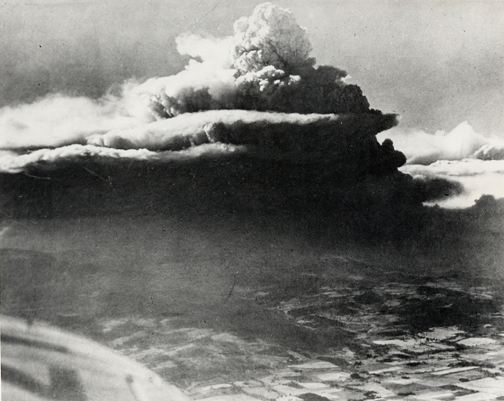U.S. Wildfire Cost-Plus-Loss Economics Project
AIR & ATMOSPHERE
Tillamook Fire smoke plume, August 24, 1933. In a single day the 1933 Tillamook Fire increased more than 200,000-acres in size, creating a mushroom cloud 40 miles wide and 8 miles high and producing hurricane-scale winds that furthered the spread of the fire. This cloud was formed largely by water vapor, ash, soil, carbon monoxide, and carbon dioxide in nearly immeasurable amounts and proportions (photo from Portland, Oregon Oregonian, used by permission of the Oregon Department of Forestry).
Air and atmospheric effects. Direct losses are related to air pollution, including particulate, noxious gases, and CO2 emissions, and visibility impacts to road and air transportation, especially if delays and/or accidents result. Indirect losses are related to public health effects, property damage, and compromised recreational opportunities. Post-fire losses include additional air pollution controls, carbon mitigation costs, added administrative overhead, and future reductions in business, job, and tax revenues.
Case Studies.
1992 Fountain Fire; 2001 Star Fire; 2007 Angora Fire; 2007 Moonlight Fire, California (Bonnicksen2008b).
2003 Uinta Fire, Utah (Brunson & Evans 2005)
General References.
Bonnicksen, Thomas M. 2008a. Forest Carbon And Emissions Model: Overview and Technical Information (beta version). FCEM Report No. 1, The Forest Foundation, Auburn, California: 28 pp.
Sandberg, David V., Roger D. Ottmar, Janice L. Peterson, John Core 2002. Wildland Fire On Ecosystems: Effects of Fire on Air. USDA Forest Service Rocky Mountain Research Station, General Technical Report RMRS-GTR-42-vol.5: 79 pp.
Weisshaupt, Brad R., Matthew S. Carroll, Keith A. Blatner, William D. Robinson, and Pamela J. Jakes 2005. "Acceptability of Smoke From Prescribed Forest Burning in the Northrn Inland West: A Focus Group Approach," Journal of Forestry. June: 189-193.
Property
|
|||||
Energy
|
Heritage
|
© 2009 Oregon Websites & Watersheds Project, Inc. and Western Institute for the Study of the Environment.
